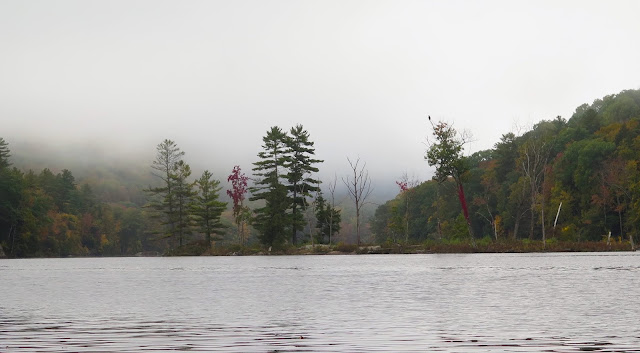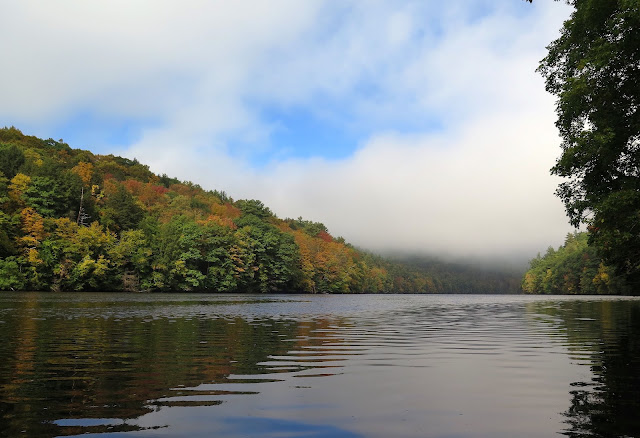The weather forecast said "clear and mild," so my friend Ruth and I agreed to meet for a paddle on the Hudson River at Moreau last week. As we prepared to launch at mid-morning, however, that clear sky still remained obscured by fog. No matter. We were there to inch along the banks looking for mosses, not scan the skies nor bask in the sun.
Soon, we began to glimpse blue sky, as the fog lifted off to reveal some autumn colors among the shoreline forest.
Before long, we were grateful for the leafy overhanging branches offering shade.
Right off, I was delighted to find these plants of Great St. John's Wort (Hypericum ascyron), now bearing their distinctive fat seed pods. This plant is rated as Rare in New York, but it does seem to like these unspoiled banks of the Hudson River.
Forested mountains fall directly down to the shore along this stretch of river, and in places, the rocky banks are thickly carpeted with many mosses.
This particular rocky bank was home to masses of Apple Moss (Bartramia pomiformis), a lovely green moss that bears spore capsules as round as apples.
Here was a moss that was covering the wood of a tree root instead of rock, but since it is a known calciphile (lime-lover), the surrounding rocks undoubtedly contributed the nutrients if prefers.
A closer look at this moss revealed stems as ropy as dreadlocks, along with sharply pointed spore capsules. Called Entodon seductrix, it has no descriptive common name that I could find, although with a sexy scientific specific name like seductrix, it might be fun to make one up. Maybe "Rapunzel's Hair" or "Medusa's Head"?
My attention was drawn first to these brilliant orange fungi (small as baby peas), but then I noticed the fern-frond-like leaves of Pocket Moss (Fissidens osmundioides) covering the rock face beneath them.
I just this year learned to ID Pocket Moss, and now I seem to find it all over the place. I picked up a rock to examine the flat-leaved liverwort covering it and discovered many tiny fronds of Pocket Moss poking up through it. But then I neglected to ascertain the name of the liverwort!
UPDATE: Ruth has since reminded me that this liverwort is most likely a species of Pellia.
I did not get a liverwort name, either, for this green stuff covering a wave-wetted rock right at the waterline. And I never will, either, since Ruth has since told me that this is a LICHEN, not a liverwort. (She found its name and description on a site posted by The Ohio Moss & Lichen Association.) Called Dermatocarpon luridum, this lichen grows on wet rocks exclusively, with its typical habitat being rocks often washed by water. Like these rocks at the waterline of the Hudson River.
Here's a closer look at this water-washed lichen, Dermatocarpon luridum.
Another lichen we found was this patch of cup-shaped Cladonia lichens, sharing a niche in an exposed tree root with a patch of green moss. A much drier habitat than the previous lichen prefers.
When lunch-time arrived, we found a tiny quiet cove out of the river's current where we could rest our paddles and stretch our legs.
This beautiful Flowering Dogwood tree (Cornus florida) towered over the cove, its leaves well on their way to the bright-red color they usually turn in the fall.
An interesting fungal find was this Leafy Jelly Fungus (Tremella foliacea) growing on a fallen tree trunk.
At the base of this same trunk, but right at the water's edge, I discovered this jelly-like mass and did not recognize it. I wonder if it's the same as the Leafy Jelly Fungus above, but with the leafy parts swollen from being constantly wet. UPDATE: Some mushroom expert friends have confirmed that my guess about this water-swollen fungus was correct!
Some sections of the shoreline here are ruggedly rocky, great chunks of boulders having toppled down from steep cliffs above. Rosy-leaved Virginia Creeper (Parthenocissus quinquefolia) twined amid the boulders.
Overhead, American Basswood branches (Tilia americana) dangled clusters of seeds, their golden leaves brilliant against the clear blue sky.
These trailing leaves of Groundnut (Apios americana) had achieved a beautiful variegated pattern as their chlorophyll retreated. (Note the large sharply-toothed leaves of American Elm [Ulmus americana] on the right.)
Such a lovely surprise, to find the dainty pink flowers of Herb Robert (Geranium robertianum) still vigorously blooming above their beautiful lacy leaves!
Well, we had spent nearly four hours moseying along the banks, and maybe we had traveled a quarter-mile. As we turned our canoes around to head for home, we spied this young woman vigorously paddling down the middle of the river, her dog so handsomely standing in the prow. She would certainly go much further and faster than we had paddled today! But I bet she wouldn't see nearly as much of the treasures these riverbanks offer. As they say, "different strokes for different folks."























6 comments:
The book "Common Mosses of the Northeast and Appalachians" by Karl B. McKnight, Et al. lists the common name of Entodon seductrix as "Cord Glaze Moss. (Page 291)
Fascinating finds! I do like the liverworts best.
Wondering if you knew you captured a Bald Eagle perched on the top of that snag on the island in your first photo. They like that spot.
Fun read, as usual.
I was going to ask about the same thing as Anonymous.
Thanks, dear readers, for stopping by to add your comments. I'm glad to know that Entodon seductrix does have a common name, but the one New Hampshire Gardener cites (Cord Glaze Moss) somehow disappoints me, since it really doesn't reflect the suggestiveness of its specific name.
Furry Gnome: I'm glad I could picture a liverwort for you, even if I didn't get its name.
Thanks to Anonymous and greentangle, I went back to my original photo of that foggy river and zeroed in on what they suggested might be a perching Bald Eagle. And so it WAS! Thanks for pointing that out. Yes, Bald Eagles commonly fish these waters, and now even nest nearby.
Another botanical adventure -- thanks for taking us along.
Post a Comment